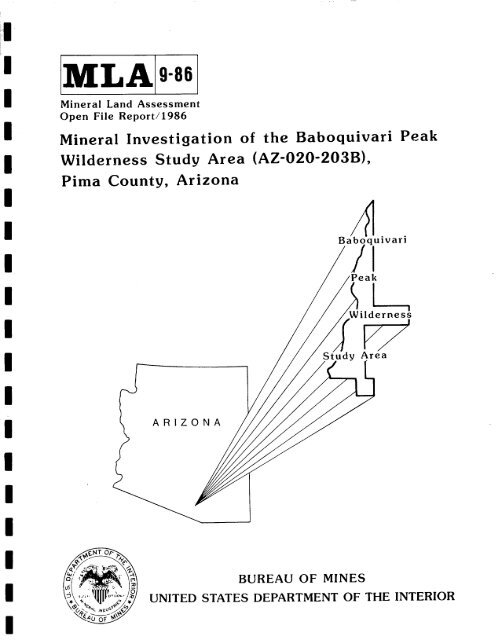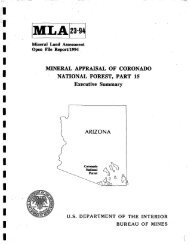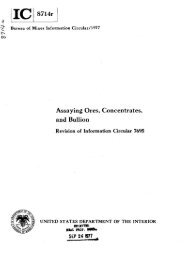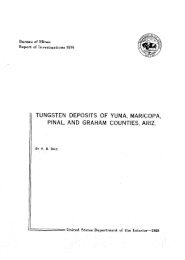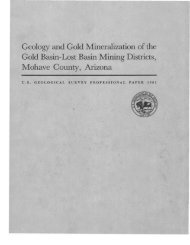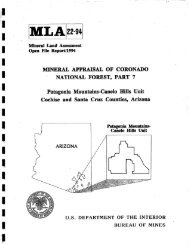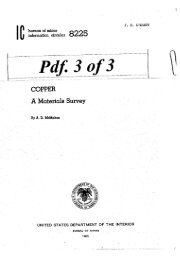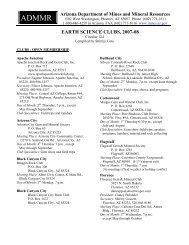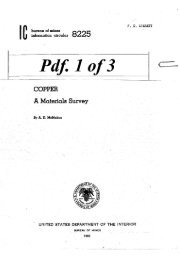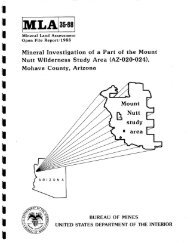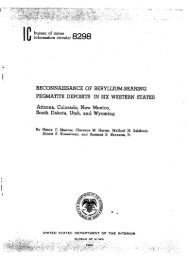MLA 9-86 - State of Arizona Department of Mines and Mineral ...
MLA 9-86 - State of Arizona Department of Mines and Mineral ...
MLA 9-86 - State of Arizona Department of Mines and Mineral ...
You also want an ePaper? Increase the reach of your titles
YUMPU automatically turns print PDFs into web optimized ePapers that Google loves.
ii~ Jl ~ rIIIIIIIIIIII|IIIIMINERAL INVESTIGATION OF THE BABOQUIVARI PEAK WILDERNESSSTUDY AREA (AZ-020-203B), PIMA COUNTY, ARIZONAbyJohn R. McDonnell, Jr.<strong>MLA</strong> 9-<strong>86</strong>19<strong>86</strong>Intermountain Field Operations Center, Denver, ColoradoUNITED STATES DEPARTMENT OF THE INTERIORDonald P. Hodel, SecretaryBUREAU OF MINESRobert C. Horton, Director
iIIIIIIIIIIIIIIIICONTENTSSummary .................................................................. 1Introduction ............................................................. 1Method <strong>of</strong> investigation ............................................. 2Geographic <strong>and</strong> 8eologic setting ..................................... 2Mining history ........................................................... 3Energy resources ................... ......................................<strong>Mineral</strong> appraisal ....................................................... 7Conclusion ...............................................................References ...............................................................Figure i..ILLUSTRATIONSIndex map <strong>of</strong> the Baboquivari Peak Wilderness Study Area,Pima County, <strong>Arizona</strong> ........................................MininE activity in the vicinity <strong>of</strong> the Baboquivari PeakWilderness Study Area, showing simplified geology ...........UNIT OF MEASURE ABBREVIATIONS USED IN THIS REPORTftmippm%ItstOZfoot/feetmile(s)part(s) per millionpercentton, long (2240 pounds)ton, short (2000 pounds)troy ounce(s)iiPa~e5I0
IIIIIIIIIIIIIIIIIIIsurrounding area. Current (1985) BLM records show two patented mining claimsabout 2 i12 mi south <strong>of</strong> the WSA <strong>and</strong> one unpatented claim less than 1 mi east<strong>of</strong> the northern tip <strong>of</strong> the WSA (fig. 2). The establishment <strong>of</strong> the PapagoIndian Reservation (fig. i) in 1955 closed the western part <strong>of</strong> the district tomineral entry under rules <strong>of</strong> the 1872 Federal Mining Act.Mining in the Baboquivari district beEan in the late 1800's at theAllison <strong>and</strong> Jupiter mines (fig. 2). Keith (1974, p. 14-17) summarized thegeology <strong>and</strong> history <strong>of</strong> the district, <strong>and</strong> estimated a total production <strong>of</strong>57,000 st <strong>of</strong> ore containing about 14,000 oz gold, 173,000 oz silver, 122 stcopper, 12 st lead, <strong>and</strong> a small amount <strong>of</strong> zinc, plus about 24 st <strong>of</strong> tungstenconcentrates <strong>and</strong> 200 it <strong>of</strong> manganese ore. A small amount <strong>of</strong> placer gold hasalso been recovered.Most <strong>of</strong> the nearby mining activity was either west to horthwest or southto southwest <strong>of</strong> the WSA. Figure 2 summarizes the activity that has takenplace within 3 mi <strong>of</strong> the WSA. Two groups <strong>of</strong> tungsten deposits, one 9-12 minortheast <strong>of</strong> the WSA near San Juan Spring <strong>and</strong> the other 6-8 ml southwest <strong>of</strong>the WSA near Chutum Vaya (fig. 1), are not shown but have contributed to thetotal production reported above.ENERGY RESOURCESThere have been no reported oil or gas discoveries, or Federal leases orlease applications filed in the Baboquivar£ WSA. Ryder (1983) evaluated thepetroleum potential <strong>of</strong> wilderness l<strong>and</strong>s in <strong>Arizona</strong> on the basis <strong>of</strong> geologicframework <strong>and</strong> petroleum geology derived from published literature. Theevaluation rated the WSA among a group that has "zero" potential because anyoil or gas accumulations would have been subject to migration or destructiondue to later tectonic <strong>and</strong> magmatic activity.
OTgAllisonMineOTgTrBl/o!k Dragon MineLost Horse Mine (?)'Jm ~ Jpi!dbTKcJbdbJpiJPDonna 1Tr/Iclaim / ContrerosI~1 I Canyon |AreaBABOQUIVARI~ WILDERNESSSTUDY AREATJ's \ JpPEAl~ Jpi /Ipper Brown Diablo) Canyon prospectI18.SSc QYgTrTtsTKeKJc~ ~ Jb~- JP7. Ij mJplIJ a['°L~PI2~ATIONGravel <strong>and</strong> allnvlu~Sedimentary, volcanic, <strong>and</strong> intrusive rocksE-hyodaclte porphyry <strong>of</strong> TinaJa SpringConglomerateChiull Sheik Formation--volcanic,sedimentary, <strong>and</strong> intrusive rocksPerthite granite <strong>of</strong> Baboqulvarl PeakGranite <strong>of</strong> Pavo Kug WashMulberry Wash Formation~volcan!c,sedimentary, <strong>and</strong> intrusive rocksPitolkam Formatlon--sedlmentary rocksAll D[ollna Formation--metasedlmentary rocksMetamorphic rocks <strong>of</strong> Chutum Vaya--metasedimentary rocks <strong>and</strong> subordinatemetavolcanlc <strong>and</strong> metaplutonlc rocksN.I~.E / LOCATIONAllison MineT.18S., R.7E.,center see. 33(unsurveyed).Black Dragon MineT.18S., R.7E.,SE i/4 sec. 15,h~ 1/4 sec. 22(unsurveyed).Contreras Canyon area(includes Hop Sage,Shamrock, Windy,<strong>and</strong> Donna IIl)T.18S., R.SE.,sets. 19-21, 28-30.Diablo prospectT.19S., R.8E.,N center sac. 16.Edna J. PlacerT.19S., R.SE.,sets. 31-32,T.20S., R.8E.,sees. 5-6.Gold Bullion MineT.19S., R.TE.,S center sec. 35,T.20S., R.TE.,N center sac. 2.CO..~2~.9DITIESAg, A~, Cu,Pb, Hn.MnBeCuAuAu, Ag, Mo,Cu, Pb, W,V, Zn.DEVELOPMJB~T / GEOLOGY / PRODUCTIONSeveral thous<strong>and</strong> feet <strong>of</strong> undergroundworkings <strong>and</strong> mill ruins; mineralizedq~artz veins occur in NW-strlklnB,steeply SW-dlpplng shear zones in partlymetamorphosed sedimentary rocks <strong>and</strong>rhyolitic to <strong>and</strong>esltic flows <strong>and</strong>intrusions; production estimated at over47,000 tons <strong>of</strong> ore averaging 0.22 ozgold/ton, 2.7 oz silver/ton, <strong>and</strong> minorlead <strong>and</strong> copper.Opencuts <strong>and</strong> pits; discontinuous lenses,coatings, <strong>and</strong> fracture-fillings <strong>of</strong>manganese minerals In sheared <strong>and</strong>brecelated rhyolite; production to 195~,165 long tons <strong>of</strong> ore averaging 27.6%manganese, <strong>and</strong> 19 tons <strong>of</strong> concentrateaveraging 36.0% manganese.Shallow trenches <strong>and</strong> exploratory drilling;mineralized quartz veins <strong>and</strong> peg~atltesup to 3 ft thick in granite, typicallyNW-strlklng sod steeply dipping, "few"thous<strong>and</strong> tons <strong>of</strong> inferred reserves at0.002% BeO; no known production.30-it-deep shaft; mineralization occurredalong a narrow fracture zone in arhyolite dike; no known production.Small intermittent placer operation;finely divided gold in a 6- to ll-ftthickgravel bar; few tens <strong>of</strong> oz goldrecovered.Several hundred ft <strong>of</strong> underground workings<strong>and</strong> mill ruins; discontinuous mineralizedquartz fissure veins <strong>and</strong> pegmatites up to12 ft thick cutting partly metamorphosedsedimentary rocks, granite, <strong>and</strong> rhyolitedikes, typically NW-striklng with nearvertical dip; intermittent production <strong>of</strong>at least 3,100 tons <strong>of</strong> ore averaging about1.0 oz gold/ton, 12 oz silver/too, severalhundred tons <strong>of</strong> high grade molybdenum, <strong>and</strong>minor copper, lead, tungsten, <strong>and</strong> vanadium.REYBR -~;CESKelth, 1974;US Bureau <strong>of</strong><strong>Mines</strong> filedata.Keith, 1974;US Bureau <strong>of</strong>Mlaes filedata.US Bureau <strong>of</strong>Hlnea filedata;Ariz Bureau <strong>of</strong><strong>Mines</strong> filedata.Donald, 1959.Keith, 1974.Keith, 1974;US Bureau <strong>of</strong><strong>Mines</strong> filedata;Arlz Bureau <strong>of</strong><strong>Mines</strong> filedata.,Qtg,drnGold Bullion Mine'OI! I~i~er Mine /Tts ~ ~ / / ~~o~.~2 3 4 5mi~, ~ ~ .... "1 -N-i( !ContactFault, dashed where approximateArea <strong>of</strong> minerals exploration activityUnpatented claim on file with BLM,as <strong>of</strong> September 1985Pate=ted mining claimsJupiter Mine area(includes Iowana~Ins)T.19S., R.TE.,NW 1/4 see. 35.Lost Horse Mine (7)T.18S., R.7E.,sec. 24(unsurveyed).Upper Brown CanyonT.19S., R.8E.,SW 1/4 sec. 7,NW 1/4 see. 18,T.19S., R.7E.,SE i/4 sec. 12,NE 1/4 sea. 13.Au, Ag, Pb,Cu, Zn, W.Ms, Au, Ag,Cu (?).Au (z), ~(~)Several thous<strong>and</strong> ft <strong>of</strong> underground workings<strong>and</strong> mill ruins, exploratory drilling forlarge tonnage, low grade open pit operationin 1974 yielded negative results;discontinuous mineralized quartz-calcitefissure veins cutting partly metamorphosedsedimentary rocks, granite, <strong>and</strong> dioritedikes; intermittent production thru 1941<strong>of</strong> several hundred tons <strong>of</strong> ore averagingi oz gold/ton, 16 oz silver/ton, <strong>and</strong>minor lead <strong>and</strong> copper.About 200 ft <strong>of</strong> underground workings;fracture filling in fault zone cuttingpartly metamorphosed sedimentary rocks;no known production.Mlnor prospecting by past l<strong>and</strong>owner alongdike system, may be same as Cruver <strong>and</strong>others locality 98; Bureau fieldcheck could not locate any evidence <strong>of</strong>prospecting or production.Kelth, 1974;Ariz Bureau <strong>of</strong><strong>Mines</strong> filedata.US Bureau <strong>of</strong><strong>Mines</strong> filedata.Kip Ripley,Tucson, ~,oral commun.~1985;Cruver sadothers, 1982.MAP LOCATIONFigure 2.--Mining activity in the vicinity <strong>of</strong> the Baboquivari Peak Wilderness StudyArea, showing geology simplified from Haxel, May, <strong>and</strong> others (1980; 1982).
No geothermal waters or leasing activity are known within the BaboquivariWSA.A statewide inventory <strong>and</strong> evaluation <strong>of</strong> <strong>Arizona</strong>'s geothermal resourcesby the <strong>Arizona</strong> Bureau <strong>of</strong> Geology <strong>and</strong> <strong>Mineral</strong> Technology (1982) showed nothermal springs or wells in or near the WSA, <strong>and</strong> the area was not defined asfavorable for the discovery <strong>and</strong> development <strong>of</strong> geothermal resources.No uranium or thorium occurrences are known within the Baboquivari WSA.A regional uranium resource evaluation by Luning <strong>and</strong> Brouill<strong>and</strong> (1981) ratedthe sedimentary <strong>and</strong> volcanic rocks in the area as being unfavorable foruranium occurrences because no reductant is present. The evaluation alsorated the intrusive rocks as unfavorable because they are not anomalouslyuraniferous, even though they showed some favorable characteristics.MINERAL APPRAISALNo mineral deposits or occurrences were found within the Baboquivari PeakWSA. Cruver <strong>and</strong> others (1982) <strong>and</strong> Stipp <strong>and</strong> others (1967) reported agold-silver occurrence near the center <strong>of</strong> the WSA.Bureau personnel traversedthe area, but no gold-silver occurrence was found. Two stream sedimentsamples were collected outside the WSA from drainages in upper Brown Canyonwhere the occurrence was suspected; one <strong>of</strong> the samples assayed 0.042 ppmgold.The samples were also assayed for silver <strong>and</strong> tungsten but both sampleshad values below the lower detection limits (silver, 0.7 ppm; tungsten,0.01%). The gold was detected in a sample from a drainage from sec. 13, T.19S., R. 7E. where a prominent northwest-striking dike is exposed near theridgeline.The drainage headwaters <strong>and</strong> dike are within the southern part <strong>of</strong>the WSA.Gold, silver, molybdenum, copper, lead, manganese, tungsten, <strong>and</strong> zinchave been mined or prospected at several sites near the WSA (fig. 2).The
iIIIIiIIIIIIIIIIIoccurrences generally are related to veins associated with rhyolitic to<strong>and</strong>esitic dikes. The dikes typically strike northwest <strong>and</strong> commonly wereintruded along pre-existing faults (Haxel, May, <strong>and</strong> others, 1980). Haxel,May, <strong>and</strong> others (1980) showed a complex dike network that is generally boundedby the major northwest-striking faults shown in figure 2. The dike networkincludes most <strong>of</strong> the nearby mineralized occurrences <strong>and</strong> extends through theWSA. Keith (1974) noted a general precious- <strong>and</strong> base-metal zoning pattern <strong>and</strong>considerable sulfide mineralization on the eastern side <strong>of</strong> the Baboquivaridistrict <strong>and</strong> suggested the possibility <strong>of</strong> a hidden porphyry-type deposit alongthe northwest-striking structural trend.Beryllium occurrences have been prospected in the Contreras Canyon areai-2 mi northeast <strong>of</strong> the WSA. The beryllium values are in quartz veins <strong>and</strong>pegmatites in granite <strong>and</strong> typically strike northwest. Although veins <strong>and</strong>pegmatites striking northwest from the Contreras Canyon area would not extendinto the WSA, Haxel, May, <strong>and</strong> others (1980) reported that the complex dikenetwork discussed above may include some aplite <strong>and</strong> pegmatite dikes.Beryllium-enriched veins <strong>and</strong> dikes may therefore occur within thenorthwest-striking structure that passes through the WSA.CONCLUSIONNo mineral or energy resources are known within the Baboquivari PeakWSA. Occurrences <strong>of</strong> gold, silver, molybdenum, beryllium, copper, lead,manganese, tungsten, <strong>and</strong> zinc, however, have been mined <strong>and</strong> prospected within3 mi <strong>of</strong> the study area. The mineralized rock generally is in anorthwest-striking zone <strong>of</strong> faults <strong>and</strong> dikes that extends through the WSA.Although no exposed mineral occurrences are known in the WSA, geologicalfeatures that are mineralized nearby are known to extend into the study area.8
If the mineralization extended along these features, then occurrences <strong>of</strong> gold,silver, molybdenum, beryllium, copper, lead, manganese, tungsten, <strong>and</strong> zinccould be present below surface in the WSA.It also has been suggested that aporphyry-type deposit could he hidden along this trend.A detailed geological <strong>and</strong> geochemical survey <strong>of</strong> the dikes within thestudy area would be necessary to determine if the mineralizing processes haveoccurred through the WSA.9
IIIIIIIIIIIIIIIIIREFERENCES<strong>Arizona</strong> Bureau <strong>of</strong> Geology <strong>and</strong> <strong>Mineral</strong> Technology, 1982, Geothermal resources<strong>of</strong> <strong>Arizona</strong>: map, scale 1:500,000.Cz~/ver, S. K., Crl/ver, Jack, Wodzicki, A., <strong>and</strong> Krason, Jan, 1982, Geology,energy <strong>and</strong> mineral resources assessment <strong>of</strong> the Kitt Peak area, <strong>Arizona</strong>:Geoexplorers International, Inc., Denver, Colorado, prepared for: U.S.Dept. <strong>of</strong> the Interior, Bureau <strong>of</strong> L<strong>and</strong> Management, p. 88-92.Donald, P. G., 1959, Geology <strong>of</strong> the Fresnal Peak area, Baboquivari' Mountains,<strong>Arizona</strong>: University <strong>of</strong> <strong>Arizona</strong>, Tucson, M.S. Thesis, 45p.Haxel, Gordon, May, D. J., <strong>and</strong> Tosdal, R. M., 1982, Reconnaissance geologic map<strong>of</strong> the Presumido Peak Quadrangle, <strong>Arizona</strong>: U.S. Geological Survey MapMF-1378, scale 1:62,500.Haxel, Gordon, May, D. J., Wright, J. E., <strong>and</strong> Tosdal, R. M., 1980,Reconnaissance geologic map <strong>of</strong> the Baboquivari Peak Quadrangle, <strong>Arizona</strong>:U.S. Geological Survey Map MF-1251, scale 1:62,500.Haxel, Gordon, Wright, J. E., May, D. J., <strong>and</strong> Tosdal, R. M., 1980,Reconnaissance geology <strong>of</strong> the Mesozoic <strong>and</strong> lower Cenozoic rocks <strong>of</strong> thesouthern Papago Indian Reservation, <strong>Arizona</strong>: A preliminary report:<strong>Arizona</strong> Geological Society Digest, v. 12, p. 17-29.Heindl, L. A., <strong>and</strong> Fair, C. L., 1965, Mesozoic (?) rocks in the BaboquivariMountains, Papago Indian Reservation, <strong>Arizona</strong>: U.S. Geological SurveyBulletin 1194-I, 12p.Keith, S. B., 1974, Index <strong>of</strong> mining properties in Pima County, <strong>Arizona</strong>:Bureau <strong>of</strong> <strong>Mines</strong> Bulletin 189, 156 p.Ariz.Luning, R. H., <strong>and</strong> Brouill<strong>and</strong>, L. A., 1981, Uranium resource evaluation,Nogales Quadrangle, <strong>Arizona</strong>: Bendix Field Engineering Corporation, Gr<strong>and</strong>Junction, Colorado, prepared for the U.S. <strong>Department</strong> <strong>of</strong> Energy undercontract No. DE-ACI3-76GJ01664, 87p.Ryder, R. T., 1983, Petroleum potentlal <strong>of</strong> wilderness l<strong>and</strong>s in <strong>Arizona</strong>, i__nnPetroleum potential <strong>of</strong> wilderness l<strong>and</strong>s in the western United <strong>State</strong>s:U.S. Geological Survey Circular 902 A-P, p. CI-C22.Stipp, T. F., Haigler, L. B., Alto, B. R., <strong>and</strong> Sutherl<strong>and</strong>, H. L., compilers,1967, Reported occurrences <strong>of</strong> selected minerals in <strong>Arizona</strong>: U.S.Geological Survey <strong>Mineral</strong> Investigations Resource Map MR-46, scale1:500,000.i0


